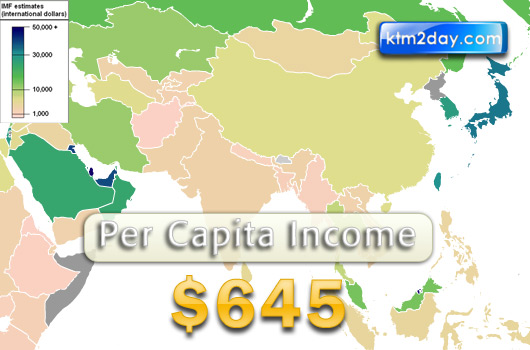Nepal’s per capita income jumped to $645


Despite the economy not faring well, the country has achieved some success in social sectors in the fiscal year (FY) 2010-11. The Economic Survey 2011, presented in the Legislature-Parliament on Thursday, shows the average income of a Nepali has increased this year. It says Nepal’s per capita income jumped to $645 (Rs 46,020) this FY, up from $561 (Rs 40,027) in the last FY.
The growth in the income has resulted in increased consumption, according to the survey. Savings compared to the gross domestic product (GDP) is expected to remain at a mere 6.7 percent—the lowest in 11 years. “It is due to the rise in consumption expenditure,” the survey says.
Growing consumption of petroleum products and LPG illustrates this fact. Consumption of petroleum products grew by 13.2 percent to 631,951 kilolitres in the first eight months of the current fiscal year, while the consumption of LPG grew by 16.4 percent to 100,540 metric tonnes.
Former vice-chairman of the National Planning Commission (NPC) Jagadish Chandra Pokharel said that despite the growth in income as a result of remittance and GDP growth, high inflation and changed lifestyle resulted in low saving rates.
“It is better to have a high saving rate for a poor country like Nepal,” he said.
Given the survey showing possible economic growth of 3.5 percent, the role of the agriculture sector—whose growth is expected to remain at 4.1 percent—has remained important. The estimated growth of paddy production remained at 11 percent to 4.46 million metric tonnes despite the expansion of paddy cultivation area by just 1 percent.
The estimated growth of maize production was also 11.5 percent to 2.06 million metric tonnes and millet production was expected to rise by 1 percent.
Among the key cash crops, the estimated sugarcane growth this year stands at 13 percent to 2.93 million metric tonnes. Production of food oil products, potatoes and pulse products are estimated to grow. However, production of tobacco and jute has suffered a decline.
The production of fruits is estimated to grow to 725,000 metric tonnes this year from 705,000 last year. Vegetable products are estimated to grow by 7 percent to 3.2 million metric tons. The production of milk, meat and fish is also expected to grow this year. The cereal production saw good days due to good climate, according to the survey.
In the non-agriculture sector, industry, hotel and restaurant, transportation, communication, financial sector, health and social sector are expected to see growth. However, electricity, gas and water and wholesale and retail sales are expected
to see negative growth, the survey says.
The industrial sector that will see a slow growth of 1.5 percent will witness a growth in the production of mustard oil, rice, wheat flour, readymade garment, lube oil, medicines, soap and bricks.
However, the production of soybean oil, biscuit, beer, soft drinks, jute, leather, paper products, plastic, concrete, Hume pipe, iron and steel, GI pipe and electricity wire will see a decline.
There has been a mere 0.3 percent growth over the last five years in the sector. The real estate sector is expected to grow by just 2.6 percent compared to 3.6 percent last year, due to stringent measures against lending in the sector by the government and central bank.
Given the improvement in the tourism sector, the hotel and restaurant sector is likely to see a growth of 7.4 percent this year. During the period from mid-January 2010 to mid-January 2011, the number of star hotels increased to 103 from the earlier 97.
Though development spending took a beating this year, the government added 1,317 km of new roads to country’s road network. With this, the country’s road network increased to 21,455 km including 6,874 km blacktopped.
In the social sector, the investment has been growing. The number of primary, lower secondary and secondary schools has gone up to 32,684, 11,939 and 7,559 respectively. However, the growth rate in the sector is expected to remain at 2.9 percent as compared to 7.3 percent last year. This sector has witnessed a growth of 6.9 percent over the last five years.
The growth rate in the health sector is expected to remain at 5.9 percent this year. The average growth rate of the sector has been 6.9 percent over the last five years.(Source:ekantipur)
















